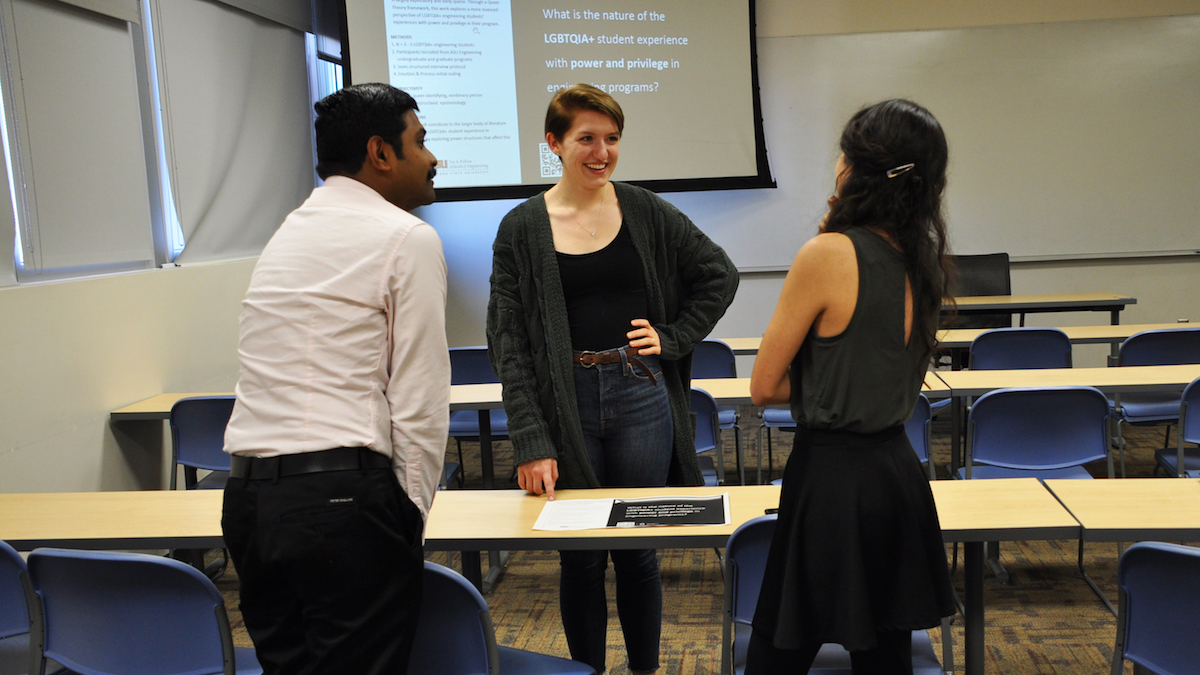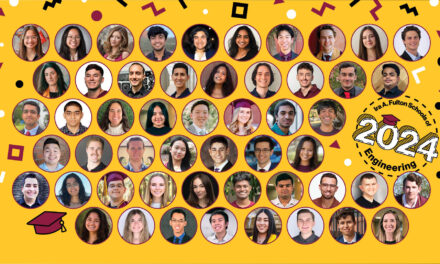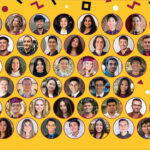
Doctoral student devoted to promoting LGBTQIA+ inclusion in STEM
National Science Foundation Graduate Research Fellowship winner chose ASU to pursue mission to foster equality

Above: After Madeleine Jennings (center) gave a recent presentation on a key aspect of their doctoral research — challenges faced by LGBTQIA+ students in engineering programs — they discussed the subject with Bala Vignesh Sundaram (left) and Cecilia Laplace, fellow students in the engineering education and system design doctoral program in the Ira A. Fulton Schools of Engineering. Photographer: Nadia Kellam/ASU
Madeleine Jennings recalls being a child who was constantly tinkering and taking things apart to understand how they worked.
That inclination blossomed into “an affinity for the sciences,” says Jennings, who identifies as queer and prefers gender-neutral pronouns.
Jennings excelled in science classes in high school, winning the chemistry department’s award of excellence in their senior year. With encouragement from their parents, Jennings decided to pursue a career in a STEM field — science, engineering, technology and math.
In their freshman year at Texas State University, Jennings landed an undergraduate research position in ferrous metallurgy, focusing on grain refinement during the casting process, as well as steel quality improvement during refining and casting processes.
The experience they gained would lead to an internship with a local steel mill for three summers. In doing that work, Jennings says they “fell in love with steelmaking” and “was absolutely certain I had found my calling.”
As a result, they switched majors from chemistry to manufacturing engineering, and eventually got a tentative offer for a full-time position at the steel mill after graduation.
“I was planning to work there for a while and then go to graduate school to study metallurgy engineering,” Jennings says.
But not long before Jennings was to graduate — and shortly after they came out to their manager at the mill as a member of the LGBTQIA+ community — Jennings says they were abruptly told the mill’s budget allowed funding for only one intern and that someone else would be filling the role, effectively rescinding the full-time job offer.
Lured by intriguing engineering education research at ASU
While that door closed, another opened for Jennings to unexpectedly “stumble into” another career possibility that would soon spark their zeal for engineering education.
Needing work after losing the internship, Jennings took an engineering education research assistantship at Texas State with construction science and management Associate Professor Kimberly Talley. The job had been recommended to Jennings by their mentor in the engineering program, mechanical engineering Lecturer Austin Talley.
The research job “worked out really well,” Jennings says, and both the mentor and the research leader urged Jennings to consider getting a graduate degree in the field.
That led Jennings to attend a national conference of the American Society for Engineering Education, where they met Associate Professor Nadia Kellam, chair of the engineering education and systems design doctoral program in the Ira A. Fulton Schools of Engineering at Arizona State University, and Assistant Professor Brooke Coley, a faculty member in the program.
Jennings looked up information about the program and was “blown away” at the intriguing engineering education research being done by faculty and students. Jennings then asked Kellam and Coley to mentor them in applying to the National Science Foundation Graduate Research Fellowship Program for support to earn a doctoral degree.
GRFP fellows have opportunities for internships, professional development and participation in international research projects, and can choose to do their own research at any accredited U.S. institution of graduate education.
Acceptance into the highly competitive NSF fellowship program provides a three-year annual stipend of $34,000 and a $12,000 cost-of-education allowance for tuition and fees to pursue graduate degrees.
Jennings says the opportunities available through the Fulton Schools engineering education program made the choice an easy one.
Turning negative experience into a passion
Last January, Jennings began work as a research assistant for Kellam and Coley, just a month after receiving an undergraduate degree from Texas State.
This past spring, Jennings was accepted into the NSF graduate research fellowship program and promptly enrolled in the engineering education and systems design doctoral program in The Polytechnic School, one of the six Fulton Schools. In July, they were also accepted into the human systems engineering master’s program.
Jennings says both graduate programs are innovative, interesting, committed to student diversity and closely aligned with their own research goals.
Their career aspirations stem in a poignant way from the reason they feel they were not kept on as an intern at the steel mill in Texas. What happened reflects the fact “that the culture in some fields is not very welcoming to people like me,” Jennings says.
The engineering profession as well is “not always a welcoming place for a lot of people and I see that as a problem,” Jennings says. “I want to use my PhD and master’s degree work to get to the bottom of why that is happening and to try to find ways to fix it for all kinds of minority status people. But my focus is on the LGBTQIA+ community because it is so diverse.”
Kellam, who is now one of Jennings’ doctoral research mentors, says, “For Madeleine, they initially thought that their sexuality would not be important in their journey to becoming an engineer, but then learned differently when their full-time job opportunity was rescinded after coming out to their manager. Madeleine has turned this very negative experience into a passion to help other LGBTQIA+ students as they navigate engineering.”

Madeleine Jennings (center) and fellow engineering education and systems design doctoral students Ieshya Anderson (at left) and Katreena Thomas (at right) are shown building a Rube Goldberg machine as an educational aid for the Science, Technology, Engineering, Arts and Mathematics, or STEAM, lab at Arizona State University’s Polytechnic campus. Photographer: Tim Trumble/Tim Trumble Photography
Inclusive environments produce better engineers
There is a wealth of research on the benefits of diversity in engineering, Jennings points out, but diversity and inclusion research has focused primarily on recruiting and retaining cisgender women and ethnic minorities in engineering programs, not on “invisible populations” such as the LGBTQIA+ community.
In their NSF application statements, Jennings writes that they want their work to help lay the foundation for including “more intersectional transgender and queer individuals in engineering by providing substantiation for updating obsolete policies and curriculum, increasing visibility of the LGBTQIA+ community and providing resources for transgender and other queer students to utilize.”
“Madeleine has been very courageous in their journey, in spite of the overt discrimination that they have faced,” Kellam says. “I am looking forward to mentoring them as they begin conducting research to better understand the experiences of LGBTQIA+ engineering students and finding ways to translate this important research into practice.”
Jennings says they decided to add the master’s degree to their educational credentials because, “I’m a staunch believer in engineering education being as interdisciplinary as possible, and human systems engineering focuses on many topics important to creating an environment that is more inclusive and diverse, and that I believe produces a better all-around engineer.”
All of which, Jennings emphasizes, aligns with the NSF’s goals to support a diverse engineering student body and workforce.
Committed to advancing diversity and equity
Jennings has already assisted Kellam in writing a grant proposal to the NSF for research that would aim to broaden understanding of the experiences of LGBTQIA+ students in traditional engineering programs — for instance mechanical or electrical engineering — as opposed to a nontraditional interdisciplinary program. Another aspect is to understand what those students could do to cope with the stresses of engineering.
Jennings is particularly interested in improving the “climate” for transgender individuals, as well as other underrepresented minorities, in both engineering education and the workplace.
Such work would fill a big equality gap in the engineering profession, says Associate Professor Rod Roscoe, who is Jennings’ advisor in the human systems engineering program.
“The pursuit of inclusion needs to be all-inclusive, and LGBTQIA+ communities in engineering seem to be neglected,” Roscoe says. “We share a passion for understanding and addressing these issues in our fields.”
Diversity, inclusion and equity are increasingly important topics in engineering, he adds, noting that the American Society of Engineering Education, or ASEE, issued the Deans Diversity Pledge in 2017, in which signers, including ASU, commit to improving and promoting inclusion.
“It is exciting to see students leading and doing innovative work this area,” Roscoe says. “Jennings is a role model.”
Family support is motivating factor
Jennings is still in exploration mode on where they want to go professionally once they have earned a doctoral degree.
“Part of me wants to go into academia and do research, part of me wants to start my own business and part of me wants to start a nonprofit of some sort,” they say.
Jennings, the first in their family to graduate from a four-year college undergraduate program, acknowledges their parents, who work in a tech and engineering industry (they own a consulting company focusing on oil, gas and ethylene plant startups) for their enthusiasm for their child’s higher education endeavors.
Jennings’ spouse, a Phoenix native, clinician and teacher with the Phoenix-based Southwest Autism Research & Resource Center, also gets credit as a motivator.
“He has been an advocate for me going to grad school since we met, and I wouldn’t be here without his support,” Jennings says.
Their activities away from work and school often focus on physical fitness pursuits. Their husband “just completed an Iron Man competition and I do CrossFit training and boxing three to five times a week,” Jennings says.
Their home life also includes two cats, who are “amusing at times and annoying at other times,” they say.
For fun they play the augmented reality mobile game Pokémon Go and are currently binge-watching — in sequential order — each of the various productions of the “Star Trek” sci-fi TV series.



































